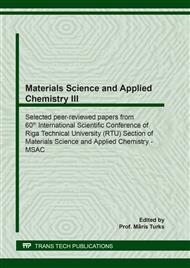p.3
p.9
p.16
p.22
p.28
p.35
p.41
p.48
p.54
Clay-Humic Substance Composites for Removal of Pharmaceuticals from Water
Abstract:
Humic substances are the main component of soil organic matter and they actively interact with substances in soils, including pollutants. Humic acid-clay mineral composite materials can be considered as prospective and low-cost sorbents for contaminant removal. The aim of this study is to develop clay mineral and humic acid composite materials and to characterise their possible applications. For this research, montmorillonite, kaolinite and bentonite were saturated with three types of humic substances: technical humic acid from lignite, humic substances extracted from raised bog peat (Latvia) and technical K humate from lignite. Obtained sorbents were characterized using FTIR. The sorption was characterised according to the chosen clay mineral and humic acid type and concentration. Comparing the influence of clay minerals and humic substances on humic matter sorption, it has been found that the sorbed amount of humic substances depend on chosen humic substances and/or clay mineral. Obtained sorbents were used for sorption of chlorpromazine. Results indicate that the most perspective sorbents for chlorpromazine removal are bentonite and bentonite modified with humic acid. However, montmorillonite-humic composites also can be used for removal of chlorpromazine from water.
Info:
Periodical:
Pages:
28-34
Citation:
Online since:
June 2020
Keywords:
Price:
Сopyright:
© 2020 Trans Tech Publications Ltd. All Rights Reserved
Share:
Citation:


